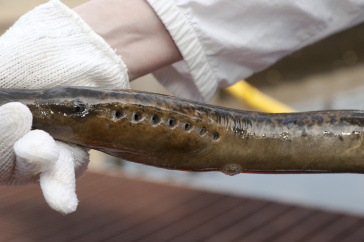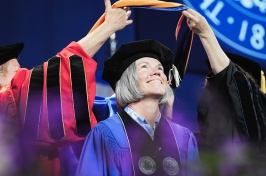UNH Researchers Contribute to First Sequence of Lamprey Genome

Sea lamprey Credit: Mike Ross, UNH Photographic Services.
DURHAM, N.H. - New genomic work by University of New Hampshire researchers sheds light on the evolutionary connection between a jawless, fish-like parasite with a tooth-lined suction cup for a mouth and humans. UNH professor of biochemistry Stacia Sower and colleagues in the Center for Molecular and Comparative Endocrinology she directs contributed to the sequencing of the sea lamprey genome. This major breakthrough in vertebrate evolution is reported in the recent issue of the journal Nature Genetics.
"Humans and lampreys both have evolved from some common ancestor," says Sower, a professor in the department of molecular, cellular and biomedical sciences. "This work helps us understand the evolution of vertebrates."
"Now we can see that the lamprey has much the same genomic content as we do. Previously, we hadn't been able to pin that down," adds Wayne Decatur, postdoctoral researcher in Sower's lab and a co-author on the study. UNH research scientist Jeff Hall also contributed to the paper.
Lampreys, along with the similarly uncharismatic hagfish, are the world's oldest living vertebrates; their lineage diverged from humans' more than 500 million years ago. Considered distinct from true fish and eels, which they resemble, lampreys have a skeleton of cartilage, one nostril, and can grow up to a yard long. Sea lampreys, one of 40 species of lamprey, attach themselves to the skin of fish and suck the blood of their prey.
Lampreys are studied as a model organism for the clues their brains and neuroendocrine systems hold to our earliest vertebrate ancestors. In 2004, the National Institute of Health designated the sea lamprey as one of nine non-mammalian organisms - each selected for its unique chapter in the evolutionary story -- for the determination of the genome.
In this article, lead author Jeremiah Smith of the University of Kentucky and dozens of collaborators present the first complete genome sequence for the sea lamprey (Petromyzon marinus), lending unique insight into the origin and evolution of the vertebrate lineage.
"The evolutionary divergence between lampreys and other vertebrates happened in deep evolutionary history -- we think somewhere between 500 and 600 million years ago," says Smith, an assistant professor of biology at the University of Kentucky. "So by comparing the lamprey genome to the genome of other vertebrates, we think that we can learn something about our deep ancestry."
The UNH researchers' contribution to the project, which involved 36 institutions and took more than two years, drew on the Center for Molecular and Comparative Endocrinology's expertise in the neuroendocrine system of the lamprey. This work holds particular promise, says Sower, for better understanding the lamprey gonadotropin releasing-hormone (GnRH) receptor, which controls reproductive physiology and has potential biomedical implications.
Like so many scientific breakthroughs, this sea lamprey genome raises far more questions than it answers, opening a floodgate of future research. "The technology increases, our knowledge increases, the complexity increases," Sower says. "But this is very exciting. We've been working on this for a long time."
Funding to the Center for Molecular and Comparative Endocrinology for this work was provided by the National Science Foundation (IOS-0849569) and the N.H. Agricultural Experiment Station. The paper, "Sequencing of the sea lamprey genome provides insights into vertebrate evolution," is available at http://www.nature.com/ng/journal/vaop/ncurrent/full/ng.2568.html.
The University of New Hampshire, founded in 1866, is a world-class public research university with the feel of a New England liberal arts college. A land, sea, and space-grant university, UNH is the state's flagship public institution, enrolling 12,200 undergraduate and 2,300 graduate students.
Photograph available to download: /unhtoday/news/releases/2012/nov/sower.jpg
Stacia Sower, professor of biochemistry and director of the Center for Molecular and Comparative Endocrinology at the University of New Hampshire
Credit: Lisa Nugent, UNH Photographic Services.
Image available to download: /unhtoday/news/releases/2013/feb/lamprey.jpg
Sea lamprey
Credit: Mike Ross, UNH Photographic Services
-30-
Latest News
-
October 24, 2025
-
October 8, 2025
-
October 2, 2025
-
September 24, 2025
-
September 15, 2025















































